
Oregonians for Medical Freedom (
An Outbreak of Hysteria in the Media about the Measles Outbreak
Throughout the recent weeks in Oregon, and across the nation, we have seen major news outlets picking up the story of a measles outbreak in SW Washington. While measles is a highly contagious disease with sometimes very serious side effects, the notion that this once routine childhood illness is deadly has been widely propagated, inciting fear in our communities, and leading to the release of controversial fear-based policy proposals.
There is nothing new about measles in the Northwest U.S. In fact, cases of measles occur in Oregon in most years. What is new is the media’s incitement of fear and panic about this virus – and just in time for the opening session in our legislature.
A January 26th article in the Oregonian states, “Years after the measles vaccine was introduced in the U.S. in 1963, the illness was thought to be all but eradicated in the country.”
According to another article published last week in the Oregonian, “Only one person out of 30 has been hospitalized so far in the current outbreak. But Melnick argues that one out of 30 is higher than it should be. Especially when the hospitalization comes from a disease that was declared eliminated from the U.S. in 2000 and is expected to affect no people every year.”
Let’s Take a Closer Look at the Facts about Measles in Oregon & U.S.
If you examine the Communicable Disease Data for Oregon, you can see that measles has popped up in 20 of the last 27 years with limited cases throughout Oregon with relatively zero effect on the population at large and no reported deaths in Oregon. (Nationwide, there are only two CDC confirmed measles deaths since 1992 and both took place in 2003.)
Selected cases of notifiable diseases by year*: Oregon 1990–2010
Selected cases of notifiable diseases by year*: Oregon 1995–2016
If you study the Oregon Health Authority Communicable Disease Summaries, you can see that most of the measles cases that do occur are a direct result of foreign travel either into the United States or a US resident traveling abroad and bringing it back. These cases typically resolve without issue and tend to stay contained, rather than rapidly spread across the state as the recent media-hype has been falsely portraying.
The measles outbreak in Clark County, Washington, stands at 51 cases. However, there have been 0 deaths and only 1 hospitalization. Authorities have not released the specific genotype of the measles strain which would indicate whether it was a vaccine-derived strain (the measles vaccine is a live virus and can cause measles on rare occasions), or if it is linked to foreign travel. But, according to the CDC, all 2019 measles outbreaks are “associated with travelers who brought measles back from Israel and Ukraine, where large measles outbreaks are occurring.”
WA Health Authorities have also not released whether or not this outbreak began in a particular close-knit community such as a church or religious group that would have close contact and concentration of under-immunized individuals. Despite this, the threat to the community at large does not appear different than any other prior incidences of measles that typically occurs here in Oregon. Yet the media coverage paints a glaringly different picture and incites a higher level of public panic than is necessary.
Please review this chart with regards to the U.S. Measles Mortality Rates. Please take special note of WHEN the Measles Vaccine was first introduced.
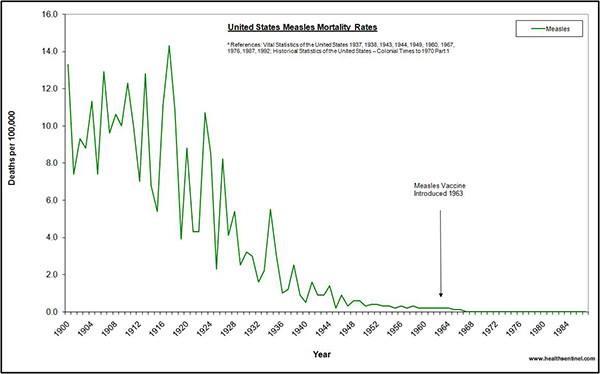
Measles in the Media: A Glance at the Recent Past
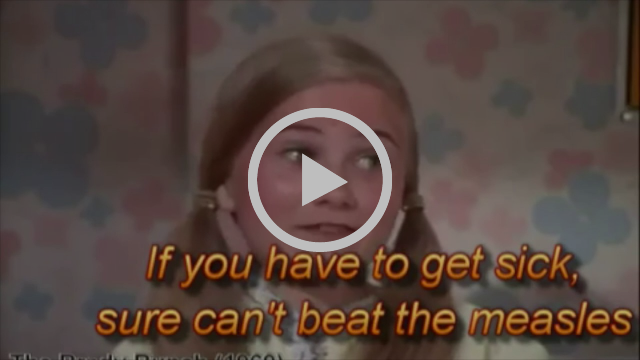
When you were growing up, did you or your siblings have the measles? Watch this blast from the past compilation of how these TV families handled measles back before the media changed to inciting fear rather than having a more rounded discussion. This is a direct reflection of popular culture values and attitudes…clearly when many of us were growing up, a case of the measles WAS NOT a reason to declare a state of emergency, let alone spur the concept of new/costly legislation and create a new statewide priority out of a non-priority issue when so many other grave concerns impact our state. (Fast forward to 2019 and see how this has changed and become hyper-sensationalized.)
#WheresTheDecline
Like the hashtag above and the image below states, “Where’s the decline?” the fear regarding measles is causing division among our diverse communities, attacking those that have not vaccinated due to a vast number of valid religious, personal or medical reasons. However, OHA data shows here that the measles vaccination rate for the state averages 95% for adolescents and two-year-old Immunization rates for MMR have remained steady. So, where is the decline the media is frantically reporting?
Are 7.5% of Oregon School Children Really Unvaccinated?
No. In fact, Oregon’s K-12 unvaccinated rate is only 2.6%. Children entering kindergarten in Oregon are required (absent an exemption) to get 17 shots containing 31 vaccines. If they are missing even just one of those shots they are captured in the data as “exempt.”
A child who has received 5 DTaP, 4 Polio, 2 MMR, 3 Hepatitis B, and 2 Hepatitis A shots is certainly not unvaccinated! But, if that child has not also received 1 chickenpox shot, he is considered “exempt.” The percentage of kindergarten students with a nonmedical exemption to one or more vaccines was 7.5%, in 2018 (see below data image). This is the number that the media uses to try to create a sense of panic by equating “exempt” to “unvaccinated.”
However, the percentage of kindergarten students in 2018 with a nonmedical exemption to all vaccines was only 4.1%, and the accurate number of children that are truly unvaccinated is a low 2.6%. Kindergarten students often have higher exemption rates for a variety of reasons: they are new to the school system and parents may be overwhelmed with the process of beginning school and the sheer number of vaccines required for school in Oregon (on the high end of states nationally for total number of required shots for school attendance) and may find it easier to file an exemption while they figure out what is required; also, final Kindergarten required doses of DTaP, Polio, and MMR can be given between 4-6 years of age, per the CDC.
A kindergartner who is still aged 5 may not have finished a series of shots, but would still be within the CDC guidelines, and would need an exemption for the final shot until it was administered. Finally, in 2006, OHA changed their exemption methodology from counting first graders to only counting kindergartners. This methodology change automatically increased the average exemption rate, since the exemption rate for first graders is lower, as children age into the final shots in the series that can be given between 4 and 6 years of age.
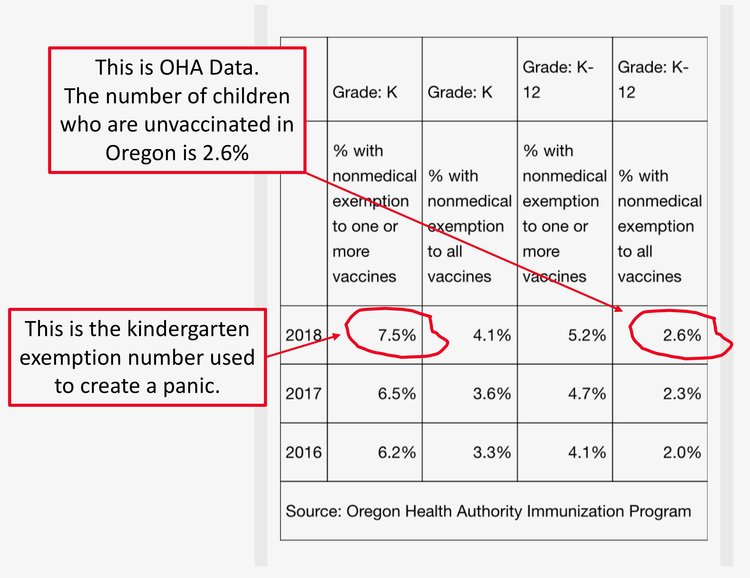
Physicians for Informed Consent Provides Evidence-Based Measles & MMR Info
Physicians for Informed Consent, a non-profit group comprised of hundreds of Physicians across the US whose mission is to unite doctors for information transparency and full informed consent, created two fact-based educational one-pagers (available in multiple languages) that you can access here, or by clicking the image below to assess the risks of measles compared to the risks of the measles, mumps and rubella (MMR) vaccine. PIC also had a letter published in The British Medical Journal (BMJ). To quote a passage:
“Our organization [PIC] has found that it has not been proven that the MMR vaccine results in less death or permanent disability than what is expected from measles.[2] The risk of dying or suffering permanent injury from measles in the United States was very small, even before the measles vaccine was introduced in 1963. Therefore, vaccine safety studies must show that the risk of dying or suffering permanent injury from the MMR vaccine is even smaller.”
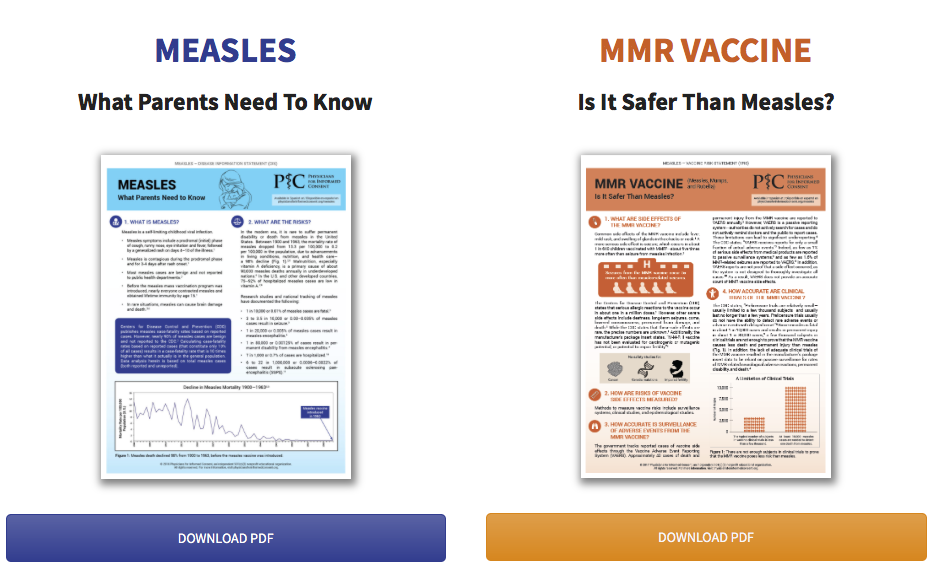
Fear-Based Policy Hurts the Most Vulnerable
OFMF routinely has citizens contact us in severe distress due to discrimination and fear-based policies that have hurt their families and their children, whether it’s being denied access to medical care when they need it—based solely on immunization records—to having healthy, uninfected kids excluded from school for 21 days or longer based entirely on immunization status rather than health status, to the most recent egregious situation of a mother being kicked out of the domestic violence shelter in which she was staying, and being put at risk for losing her job, her housing and her safety. We need to make certain that the policies proposed and passed by our legislature are helping families and not hurting them, especially the most vulnerable and economically disadvantaged.
(Read, in her own words, what this mother has been through because of fear of a typically routine childhood disease, and the severe impact this is having on her family.)
Oregon Has Health Policies Already in Place that Work
The OHA and Oregon County Health Departments have worked hard to develop existing health policies that were effectively put into practice in a live scenario on January 11th, nearly a month ago, when more than 19,000 people were in attendance at a Portland Trail Blazers game, and were potentially exposed to the measles. Despite that, we have just four confirmed measles cases in all of Oregon, and there has been no explosion of cases. That should be proof that the public health measures already in place are doing their job! The U.S. averages 250 cases of measles each and every year, and 2019 is no different, despite all the reporting to try and get you to think differently. Oregon’s MMR vaccination rate, along with three other vaccination rates tracked by the CDC, is actually above the national average!
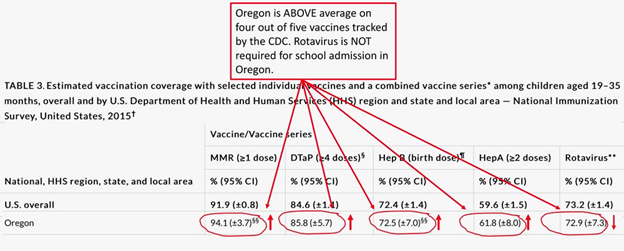
Finally, pulling an important excerpt from a physician’s response published here on the BMJ regarding a possible push for changes in legislation around vaccine exemptions.
“If vaccine exemptions are withheld from children whose families perceive them to be at high risk of an adverse reaction from the MMR, we are likely to experience an inversion in public health: fewer overall viral infections, but more vaccine reactions (and child deaths) then we have now. Public health won’t prevail, but Pharma profits will.”
